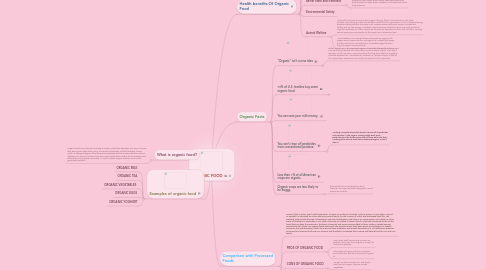
1. What is organic food?
1.1. Organic foods are produced according to certain production standards. For crops, it means they were grown without the use of conventional pesticides, artificial fertilizers, human waste, or sewage sludge and that they were processed without ionizing radiation or food additives. For animals, it means they were reared without the routine use of antibiotics and without the use of growth hormones. In most countries, organic produce must not be genetically modified
2. Examples of organic food
2.1. ORGANIC MILK
2.2. ORGANIC TEA
2.3. ORGANIC VEGETABLES
2.4. ORGANIC EGGS
2.5. ORGANIC YOGHURT
3. Organic Facts
3.1. "Organic" isn't a new idea
3.1.1. Before World War II, all crops were organic. It was only afterward that farms used new, synthetic pesticides and chemicals to minimize weed, insects, and rodent damage. What's not new? Many worry about the long-term effects of ingesting chemical residues from "conventional" produce (i.e., sprayed crops), as well as the impact these treatments have had on our planet and our resources.
3.2. 78% of U.S. families buy some organic food.
3.2.1. New Node
3.3. You can save your milk money.
3.4. You can’t rinse off pesticides from conventional produce.
3.4.1. Washing conventional produce doesn’t remove all its pesticides and transform it into organic. Rinsing might wash some pesticides from the food’s surface but not from within the flesh. (Washing does remove food-borne-illness pathogens, so don’t skip it.)
3.5. Less than 1% of all American crops are organic.
3.6. Organic crops are less likely to be buggy.
3.6.1. Because the soil is nourished by natural methods, the crops are better equipped to resist disease and insects.
4. Health benefits Of Organic Food
4.1. Reduction of Pesticide exposure
4.1.1. Pesticides are chemicals such as fungicides, herbicides, and insecticides. These chemicals are widely used in conventional agriculture and residues remain on (and in) the food we eat.
4.2. Improved Heart Health
4.3. Improved Immune System
4.4. Better taste and freshness
4.4.1. Organic food is often sold locally, resulting in availability of fresh products in the market, which usually does taste better than products that has been frozen, shipped, and transported across long distances.
4.5. Environmental Safety
4.6. Animal Welfare
4.6.1. As harmful chemicals are not used in organic farming, there is minimal soil, air and water pollution; thus ensuring a safer and healthier world for future generations to live in.Organic farming practices reduce pollution (air, water, soil), conserve water, reduce soil erosion, increase soil fertility, and use less energy. In addition, organic farming is better for birds and small animals as chemical pesticides can make it harder for creatures to reproduce and can even kill them. Farming without pesticides is also better for the people who harvest our food.
4.6.2. Animal welfare is an important aspect of producing organic milk, organic meat, organic poultry, and organic fish. People feel happy that the animals are not confined to a miserable caged life when they eat organic animal products.
5. Comparison with Processed Foods
5.1. Organic food is clean, safe, health-promoting, contains no synthetic chemicals, and are grown in a way that is natural as possible, as intended by nature while processed food is for the reasons of safety and prolonged shelf life. The methods used include freezing, refrigeration, canning, dehydrations and others. No preservatives are added, no other types of fertilizers or pesticides or any other chemicals are added in organic foods. While the processed foods are the foods that can have the pesticides, fertilizers, chemicals and preservatives added to them, within a limited amount presented in the foods. For organic foods with meat, the animals cannot have been given any antibiotics or growth hormones but with processed food, the meat can have antibiotics and growth hormones in it. The difference between processed and organic foods are very obvious and should be considered when eating and buying food for you and your family.
5.2. PROS OF ORGANIC FOOD
5.2.1. Clean, safe, health-promoting, contains no synthetic chemicals, and are grow in a way that is natural as possible.
5.2.2. Advantages of organic foods are nutrients, toxin-free, taste, and the environment it grows in.
5.3. CONS OF ORGANIC FOOD
5.3.1. We get 7% of our calories from soft drinks, which are not organic, than we do with vegetables.
5.4. PROS OF PROCESSED FOOD
5.4.1. Many processed foods are just as nutritious or in some cases even more nutritious than fresh foods that have been stored
5.4.2. Healthy processed foods are soy milk, cereal, bread, orange juice, and tofu that are fortified with calcium
5.5. CONS OF PROCESSED FOOD
5.5.1. Some processed foods are considered junk food, which is high in fat and sugar and is one of the leading causes for the soaring number of cases of type 2 diabetes, obesity, heart disease, and tooth decay.

